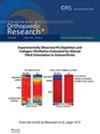Defining the segmental tension generated in a vertebral body tethering system for scoliosis
Abstract
Vertebral body tethering (VBT) uses a flexible tether affixed across the curve convexity with tension applied at each segment to treat scoliosis. Intraoperative tether tension may be achieved directly with a counter-tensioner or with an extension spring tube. The purpose of this study was to quantify the force generated with and without the extension spring tube using current FDA-approved VBT instrumentation, to understand the variation between surgeons using the same instrumentation, and to define the force range that is generated intra-operatively. Using a benchtop mechanical testing setup to simulate a spinal segment, we affixed the tether and applied tension using a tensioner and counter-tensioner alone (method T1) or by adding an extension spring tube (method T2). Eight orthopedic surgeons used T1 and T2 at six tensioner settings, and one surgeon completed three trials. A two-way ANOVA with a Tukey's HSD post hoc test (p < 0.05) compared the tensioner methods and testing levels. Inter- and intra-rater reliabilities were calculated using intraclass correlation coefficients (ICCs). Methods T1 and T2 exhibited linear tension-setting relationships, with high determination coefficients (R2 > 0.93). T2 consistently produced higher forces (increase of 62.1 N/setting), compared to T1 (increase of 50.6 N/setting, p < 0.05). Inter-rater reliability exhibited excellent agreement (ICC = 0.951 and 0.943 for T1 and T2, respectively), as did intra-rater reliability (ICC = 0.971).

 求助内容:
求助内容: 应助结果提醒方式:
应助结果提醒方式:


